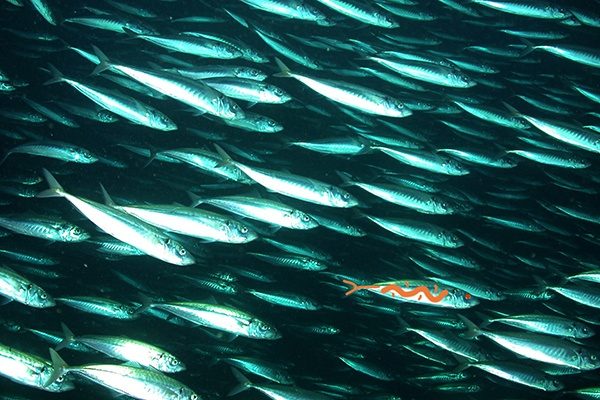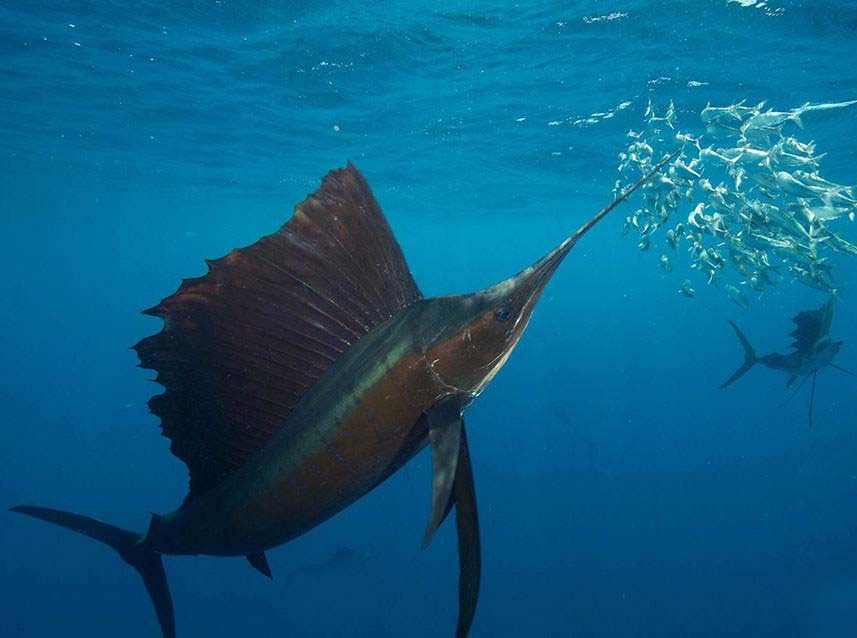What Lure Color Choice will Catch More Wahoo, Tuna, Dorado, Sailfish, and Marlin!
Pelagic species of fish (those that live in the pelagic zone of the ocean neither close to the bottom nor close to shore) such as Wahoo, Marlin, Tuna, Mahi Mahi, Sailfish and the likes are predators constantly looking for prey. Understanding how the prey color themselves through nature, and possibly evolution, in fact can help sport fishermen today attract and catch more fish.
Fishing for marlin, wahoo, tuna and these type pelagic fish has always been something that has intrigued Anglers around the world. Fishing is a sport and just an amazingly loved activity for all of us fortunate enough to have a chance to be involved with it. It is not always easy to catch the target species, so the more information we have can give the serious angler that small competitive advantage in winning their next Marlin tournament.
Lets discuss briefly the most important Pelagic zones for the species big game Anglers tend to target.
Epipelagic Zone: This is technically the zone in the ocean where photosynthesis is still possible. In general, it is the surface to about 200 meters below the surface, far from shore or the bottom. All the species we are concerned about at least visit or spend the majority of their lives in this zone. These would be fish like Wahoo, Amberjack, Mahi, Marlin, Sailfish, Tuna, etc. For the purpose of this article this is the zone we are most concerned with but lets briefly look at some others.
Mesopelagic Zone: This is the part of the Pelagic zone that extends from 200m to 1000m. Many of the above fish species visit this zone, but we rarely use fishing lures in this zone. Certainly for species such as swordfish we do often bait fish down this deep, but as fishermen we have less control of lures at these depths.
Prey fish have adapted 2 extremely important techniques for attempting to avoid predator fish (the ones we Anglers are mostly trying to catch.) The include countershading for the epipelagic zone and counterillumination for the mesopelagic zone.
Countershading Definition: “
Countershading, or
Thayer’s law, is a method of
camouflage in which
an animal’s coloration is darker on the upper side and lighter on the underside of the body. This pattern is found in many species of
mammals,
reptiles,
birds,
fish, and
insects, both
predators and
prey, and has occurred since at least the
Cretaceous period.”
Also Found here in an article about birds: href=”https://howigetridof.com/best-bird-deterrent/”
Understanding this, we can see why so many lures are created with the dark back and the lighter shinier belly. The goal of countershading for fish like sardines, mackerel, skipjack, google eyes, caballitos, etc., is so that the darker dorsal area of the animal blends into the darkness of the water below, and when seen from below, the lighter ventral area blends into the sunlight from the surface above. Similar to the image below.

So, this “camouflage” is important to understand when choosing the lure color patterns. There are several schools of thought. We know from science that this countershading coloration is the natural defense of these prey fish, but sometimes it actually works and we don’t want that!
As big game Anglers we definitely don’t want the lure coloration to be so good that it actually works, right? If it worked that well, the countershading would be effective, and the Wahoo would not even see the lure and thus would not strike it.
So the debate is whether we want the wahoo lure to appear more “natural” to the predator fish so it is tempted to strike or not. Or, would it be better to be obvious, some flaw that evolution will get rid of immediately (basically no camouflage), hence death via predator before the rest.
Lets put it this way. If a group of sardines were all hatched and they all came out with dark backs, silver and shiny belly’s, but one was born bright orange what would happen? Would the tuna eat all the others and leave that one, or would they eat that one first because it is the most simple target? Do tuna know there are artificial lures out there made to look like a genetically flawed bait?
So the big question:
Should the bait be as close to natural as possible? Or, should it stick out like a sore thumb so the fish see it first and go for it?
 Unfortunately
Unfortunately there is no clear cut answer. We have found the answer varies depending on species, other bait in the area, time of day, and geographical feeding habits.
The truth can be found fishing in your area extensively, understanding the principles of countershading, and testing the variables independently and together.
Let me give a real life example.
Manzanillo Mexico, 2001, tuna and sailfish: After catching a bunch of sailfish and literally chasing the schools of 40lbs yelllowfin around all day with no strikes, we knew something had to change. The tuna simply would not take the lures, or even some bait that we had. They were eating but not what we had to offer. We matched our lures to the small sardines they were feeding on with green backs and we sized ours to match their size. Nothing, they would not eat, it was ridiculous. We knew there were some wahoo in the area, we could not get the stupid tuna to eat, so we decided lets pull all this stuff in, put on some big weird red and pink lures, crack a beer and troll around fast. We dropped the lines back with these large wahoo lures and within 3 minutes, boom! Double hookup on tuna. Dropped the lures back and for the next couple hours we were bringing in tuna somewhat consistent. I think we ended up with 5 or 6. The next day we went back to test the theory and same thing. Tuna would only hit the big bright color lures. Action was not hot and heavy but we were putting fish on the boat.
Since 2001, I have applied this technique in one fashion or another and have seen success with it. It is never failproof by any means, but success often comes from trials. Making a mistake of thinking “the fish are just not eating” is a mistake. They will usually eat, you just have to find what is enough to entice them.
On the contrary to the above example, I have plenty of stories of the fish (especially when it comes to smaller non pelagic species) only eating something almost exactly the same as what they are accustomed to. An example of this is tuna and red crabs, or barracuda and anchovies. I have heard bluegills sometimes will only eat the same species or type of worm they are accustomed too in some lakes.
Some final conclusions:
- Do not ALWAYS try to mimic what the pelagic fish are accustomed to, but it is often effective to try.
- Study your local area with an open mind.
- DO NOT simply just assume if they aren’t biting you wont get em.
- Making a bait look natural is smart, but sometimes making it look unnatural is even smarter
 So, this “camouflage” is important to understand when choosing the lure color patterns. There are several schools of thought. We know from science that this countershading coloration is the natural defense of these prey fish, but sometimes it actually works and we don’t want that!
As big game Anglers we definitely don’t want the lure coloration to be so good that it actually works, right? If it worked that well, the countershading would be effective, and the Wahoo would not even see the lure and thus would not strike it.
So the debate is whether we want the wahoo lure to appear more “natural” to the predator fish so it is tempted to strike or not. Or, would it be better to be obvious, some flaw that evolution will get rid of immediately (basically no camouflage), hence death via predator before the rest.
Lets put it this way. If a group of sardines were all hatched and they all came out with dark backs, silver and shiny belly’s, but one was born bright orange what would happen? Would the tuna eat all the others and leave that one, or would they eat that one first because it is the most simple target? Do tuna know there are artificial lures out there made to look like a genetically flawed bait?
So the big question: Should the bait be as close to natural as possible? Or, should it stick out like a sore thumb so the fish see it first and go for it?
So, this “camouflage” is important to understand when choosing the lure color patterns. There are several schools of thought. We know from science that this countershading coloration is the natural defense of these prey fish, but sometimes it actually works and we don’t want that!
As big game Anglers we definitely don’t want the lure coloration to be so good that it actually works, right? If it worked that well, the countershading would be effective, and the Wahoo would not even see the lure and thus would not strike it.
So the debate is whether we want the wahoo lure to appear more “natural” to the predator fish so it is tempted to strike or not. Or, would it be better to be obvious, some flaw that evolution will get rid of immediately (basically no camouflage), hence death via predator before the rest.
Lets put it this way. If a group of sardines were all hatched and they all came out with dark backs, silver and shiny belly’s, but one was born bright orange what would happen? Would the tuna eat all the others and leave that one, or would they eat that one first because it is the most simple target? Do tuna know there are artificial lures out there made to look like a genetically flawed bait?
So the big question: Should the bait be as close to natural as possible? Or, should it stick out like a sore thumb so the fish see it first and go for it?
 Unfortunately there is no clear cut answer. We have found the answer varies depending on species, other bait in the area, time of day, and geographical feeding habits.
The truth can be found fishing in your area extensively, understanding the principles of countershading, and testing the variables independently and together.
Let me give a real life example.
Manzanillo Mexico, 2001, tuna and sailfish: After catching a bunch of sailfish and literally chasing the schools of 40lbs yelllowfin around all day with no strikes, we knew something had to change. The tuna simply would not take the lures, or even some bait that we had. They were eating but not what we had to offer. We matched our lures to the small sardines they were feeding on with green backs and we sized ours to match their size. Nothing, they would not eat, it was ridiculous. We knew there were some wahoo in the area, we could not get the stupid tuna to eat, so we decided lets pull all this stuff in, put on some big weird red and pink lures, crack a beer and troll around fast. We dropped the lines back with these large wahoo lures and within 3 minutes, boom! Double hookup on tuna. Dropped the lures back and for the next couple hours we were bringing in tuna somewhat consistent. I think we ended up with 5 or 6. The next day we went back to test the theory and same thing. Tuna would only hit the big bright color lures. Action was not hot and heavy but we were putting fish on the boat.
Since 2001, I have applied this technique in one fashion or another and have seen success with it. It is never failproof by any means, but success often comes from trials. Making a mistake of thinking “the fish are just not eating” is a mistake. They will usually eat, you just have to find what is enough to entice them.
On the contrary to the above example, I have plenty of stories of the fish (especially when it comes to smaller non pelagic species) only eating something almost exactly the same as what they are accustomed to. An example of this is tuna and red crabs, or barracuda and anchovies. I have heard bluegills sometimes will only eat the same species or type of worm they are accustomed too in some lakes.
Some final conclusions:
Unfortunately there is no clear cut answer. We have found the answer varies depending on species, other bait in the area, time of day, and geographical feeding habits.
The truth can be found fishing in your area extensively, understanding the principles of countershading, and testing the variables independently and together.
Let me give a real life example.
Manzanillo Mexico, 2001, tuna and sailfish: After catching a bunch of sailfish and literally chasing the schools of 40lbs yelllowfin around all day with no strikes, we knew something had to change. The tuna simply would not take the lures, or even some bait that we had. They were eating but not what we had to offer. We matched our lures to the small sardines they were feeding on with green backs and we sized ours to match their size. Nothing, they would not eat, it was ridiculous. We knew there were some wahoo in the area, we could not get the stupid tuna to eat, so we decided lets pull all this stuff in, put on some big weird red and pink lures, crack a beer and troll around fast. We dropped the lines back with these large wahoo lures and within 3 minutes, boom! Double hookup on tuna. Dropped the lures back and for the next couple hours we were bringing in tuna somewhat consistent. I think we ended up with 5 or 6. The next day we went back to test the theory and same thing. Tuna would only hit the big bright color lures. Action was not hot and heavy but we were putting fish on the boat.
Since 2001, I have applied this technique in one fashion or another and have seen success with it. It is never failproof by any means, but success often comes from trials. Making a mistake of thinking “the fish are just not eating” is a mistake. They will usually eat, you just have to find what is enough to entice them.
On the contrary to the above example, I have plenty of stories of the fish (especially when it comes to smaller non pelagic species) only eating something almost exactly the same as what they are accustomed to. An example of this is tuna and red crabs, or barracuda and anchovies. I have heard bluegills sometimes will only eat the same species or type of worm they are accustomed too in some lakes.
Some final conclusions:

